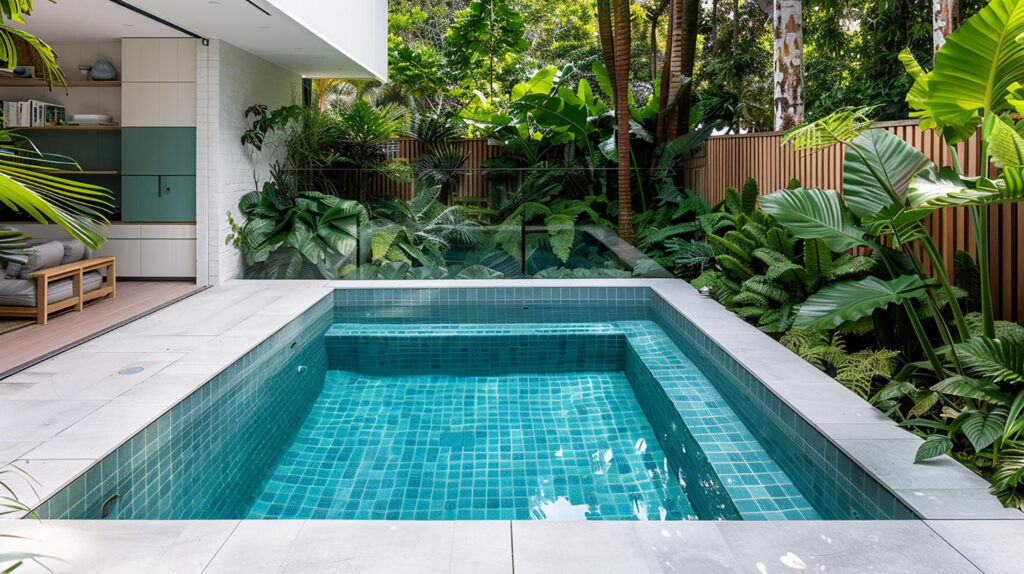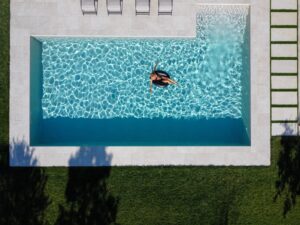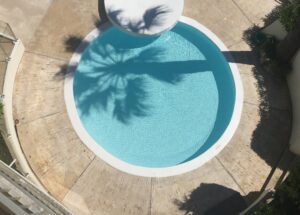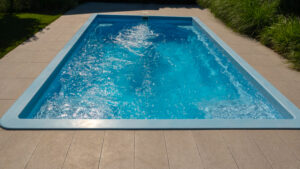Thinking about adding a plunge pool option to your home? You’re not alone. Compact pools are quickly gaining popularity among homeowners with limited space who still want to enjoy the benefits of a private pool.
A typical plunge pool measures 20 feet or less in length, 8 feet or less in width, and around 5 feet deep with a flat bottom. The perfect plunge pool plan depends on how you want to use the space, some seek a refreshing dip during hot summer days, while others value therapeutic use or compact fitness.
These pools work particularly well in small or awkwardly shaped yards where traditional pools won’t fit. They offer excellent temperature control and easier pool maintenance compared to full-sized installations. With the right planning, a plunge pool can become a long-term feature of your outdoor living area.
In this article, you’ll discover how to select the best plunge pool option for your space, needs, and budget—along with tips on installation and maintenance between these topics:
- Understanding plunge pools
- Key differences between plunge pools and traditional pools
- Factors to consider when choosing a plunge pool
- Installation, maintenance, and safety tips
Understanding plunge pools
Plunge pools offer homeowners a compact, efficient alternative to traditional swimming pools. These smaller water features provide unique benefits while requiring less space and maintenance.
In this section, you’ll understand what defines a plunge pool, how it differs from traditional pools, and why it’s an increasingly popular choice for modern homeowners.
What is a plunge pool?
A plunge pool is a small, compact swimming pool designed primarily for relaxation, cooling off, and light exercise rather than lap swimming. Typically measuring 10–15 feet in length and 6–8 feet in width, these pools tend to be deeper than they are wide, usually between 4 and 7 feet deep.
Plunge pools originated in hot climates as a quick way to cool down. Today, they’ve become a top choice in urban and suburban areas where yard space is limited.
They can be installed in-ground or above-ground and are available in materials like fiberglass, concrete, or vinyl. Some models include jets for hydrotherapy or resistance features, while others incorporate heating systems for year-round use.
Key differences between plunge pools options and traditional pools
The primary distinctions between a plunge pool and a standard swimming pool lie in size, functionality, and long-term maintenance.
The most obvious difference is size. While traditional pools often require 600–1,000 square feet, plunge pool options typically need only 150–300 square feet. This makes them ideal for small properties or yards with limited outdoor space.
They also use significantly less water—about 5,000–10,000 gallons compared to 20,000–30,000 gallons for traditional swimming pools. That translates to lower water bills and reduced chemical usage.
The cost savings are also substantial. A plunge pool installation is typically 40–60% less expensive than building a full-sized pool. Installations are quicker, less invasive, and generate less disruption to the property.
In terms of functionality, traditional pools are designed for swimming laps and recreational activities, while plunge pools are tailored for relaxing, cooling off, and therapeutic benefits like hydrotherapy.
Benefits of choosing a plunge pool
Whether you’re prioritizing wellness, maximizing limited outdoor space, or simply looking for a beautiful feature that’s easy to manage, a plunge pool plan offers surprising flexibility and long-term value for modern lifestyles.
Between the benefits of choosing a plunge pool, you can find:
- Space efficiency: plunge pool options work in areas where a traditional pool simply wouldn’t fit, making them perfect for urban homes, townhouses, or properties with small backyards.
- Lower costs: beyond the lower initial investment, plunge pools are more economical to maintain. They require fewer chemicals, less water, and less energy for heating and filtering.
- Easier maintenance: cleaning a plunge pool takes significantly less time. Skimming debris, testing chemical levels, and other routine tasks are simplified thanks to the smaller surface area, making pool maintenance easier to manage.
- Versatility: many models include features like heating, cooling, and hydrotherapy jets, allowing them to function as a hot tub in winter and a cooling pool in summer.
- Sustainability: with reduced chemical usage and smaller water requirements, plunge pools are a more eco-conscious alternative to full-sized pools.
The growing appeal of plunge pools isn’t just anecdotal, it’s backed by global market trends. According to a 2023 report by Transparency Market Research, the cold plunge pool market was valued at $413 million and is expected to surpass $648.2 million by 2034, growing at a compound annual rate of 3.9%.
Factors to consider when making a plunge pool plan
In this section, you’ll explore the practical aspects that help determine the best plunge pool option for your space, budget, and design goals.
Selecting the right plunge pool involves weighing several key factors that will impact your enjoyment and satisfaction with your investment. The size of your available space, your budget constraints, and design preferences all play crucial roles in making the best choice.
Space requirements and small footprint
Plunge pools are ideal for homeowners with limited outdoor space. These compact pools typically measure between four to seven meters in length and two to three meters in width, with depths rarely exceeding 1.2 meters.
This smaller footprint makes them perfect for urban properties, small backyards, or oddly shaped areas where traditional pools wouldn’t fit.
Before choosing a plunge pool, we recommend measuring your available space carefully. Allow for additional room around the pool for decking, seating, or landscaping elements. Remember to check local building codes for required setbacks from property lines.
The compact nature of plunge pools also means less excavation and construction disruption to your property. Many models can be installed in just days rather than the weeks or months required for conventional pools.
Budget and cost considerations
Plunge pools represent a smaller investment compared to full-sized swimming pools, making them a budget-friendly option for many homeowners. Initial costs vary based on several factors:
- Installation type: in-ground, semi-inground, or above-ground options
- Materials: fiberglass, concrete, or vinyl liner construction
- Size and depth: larger or deeper models cost more
- Features: heating systems, jets, lighting, or covers
Beyond purchase and installation expenses, consider ongoing costs. Plunge pool maintenance is generally less expensive due to reduced water, chemical, and energy use. This translates to lower monthly bills and less time spent on upkeep.
A reputable plunge pool installers offers financing options to help spread the cost of your investment. We suggest requesting quotes to understand pricing and included features.
Design and customization options
Modern plunge pool options come with various design choices to match your home’s architecture and personal style. Many manufacturers offer customizations for shell colors, finishes, and edge materials.
Features to consider include:
- Heating systems for year-round use
- Hydrotherapy jets for relaxation benefits
- LED lighting for nighttime ambiance
- Automation systems for simplified maintenance
- Safety covers for added protection and insulation
While rectangular designs maximize swim space, curved or geometric shapes may suit your layout better. Some pools can also be installed partially above ground, adding dimension and saving on excavation.
Enhancing your plunge pool experience
A plunge pool becomes truly special when you customize it to fit your lifestyle. The right features and surroundings can transform your compact pool into an extraordinary outdoor retreat that serves multiple purposes.
In this section, you’ll explore how thoughtful design choices and accessories can turn your plunge pool into a personalized wellness retreat and entertainment space.
Landscaping and outdoor integration
Thoughtful landscaping creates a seamless transition between your plunge pool and the surrounding yard. Privacy screens made from tall grasses or bamboo offer seclusion while adding a natural aesthetic.
Designating zones with strategic plantings enhances flow. Fragrant herbs like lavender or rosemary near the pool edge release pleasant scents when brushed against.
Durable, weather-resistant decking materials like composite or treated wood provide barefoot comfort. Natural stone pavers can add a premium look and feel.
To extend seasonal use, consider fire pits near the pool area. We’ve also seen great results with seating walls built from matching materials, these provide both function and cohesive design.
Built-in features and accessories
Built-in seating turns your pool into a true relaxation hub. Swim-out ledges and underwater benches offer places to cool off without fully submerging.
Jets elevate your plunge pool experience by transforming it into a hydrotherapy zone. Adjustable pressure settings allow personalized comfort. Some pools feature zones with dedicated jet placement.
LED lighting adds ambiance and improves nighttime visibility. Color-changing lights allow for custom moods.
Automatic covers make heat retention effortless while reducing debris and cleaning time. Integrated heating systems extend seasonal usability and improve comfort on cooler days.
Entertaining and recreation ideas
Plunge pool options can double as entertainment hubs. Built-in bar ledges allow guests to enjoy snacks and drinks poolside.
Nearby outdoor kitchens turn the area into a full-service hosting space. Place the grill within sightlines so the chef stays engaged with guests.
Weatherproof speakers and Bluetooth systems create an immersive soundscape. A shaded lounge area adds comfort for guests who prefer to stay dry.
Add lawn games like cornhole or bocce for variety. Even small yards can become multi-functional spaces with the right layout.
Wellness and personal retreat uses
Your plunge pool plan can support physical and mental wellness. Cold plunges after workouts reduce inflammation and aid muscle recovery.
Use waterproof diffusers to introduce aromatherapy. Scents like eucalyptus or lavender enhance relaxation.
Fitness tools like resistance bands or underwater treadmills let you perform low-impact aquatic workouts with added resistance from the water.
Create a private retreat zone with a changing cabana, towel hooks, and benches. Meditation decks near the water provide peaceful spots to start or end your day.
Installation, maintenance, and safety tips
Installing and maintaining a plunge pool requires careful planning and regular upkeep. The right installation approach and maintenance routine will ensure your pool remains safe and functional for years to come.
In this section, you’ll learn how to properly install, care for, and protect your plunge pool to ensure safety, efficiency, and long-term durability.
Working with a pool builder
Choosing the right builder is essential for a successful plunge pool installation. It’s important to research contractors, check their credentials, and review examples of previous plunge pool projects. A qualified builder will assess your site thoroughly, evaluating soil stability, access paths for equipment, and proximity to utility lines to ensure safe and efficient installation.
For homeowners in the U.S., working with a team that understands local regulations and zoning codes is critical. That’s why many choose to work directly with the experts at Little Dipper Pools, who manage the process end to end—ensuring every detail meets safety standards and exceeds expectations.
Entry systems and accessibility
The entry system you select impacts both functionality and safety. Popular options include built-in steps, ladders, or even beach-style entries that offer gradual slopes.
If your household includes children, elderly individuals, or anyone with mobility concerns, features like wider steps and handrails become essential.
Some plunge pool designs incorporate integrated seating that also serves as an access point, combining comfort with practicality. The best approach is to consider your daily use and ensure that accessibility enhances the pool experience for everyone.
Maintenance requirements
Keeping your plunge pool in top condition requires a simple yet consistent routine. Daily tasks may include skimming surface debris and checking equipment function.
Weekly upkeep often involves testing and balancing water chemistry, cleaning the waterline, and vacuuming the floor. On a monthly basis, we recommend deep-cleaning the filters, inspecting pumps and heaters, and checking for leaks or surface wear.
Because plunge pools hold less water than traditional pools, imbalances in pH or chlorine can escalate more quickly, making regular maintenance essential.
Many homeowners benefit from automated cleaning systems, but even with technology, we advise keeping an eye on performance to catch issues early.
Safety practices and warranty
Safety should always be top of mind. Be sure your plunge pool area includes fencing that meets local codes, typically four feet in height, with self-latching gates. Non-slip decking, pool alarms, and a readily accessible first-aid kit help minimize risk around the pool.
Warranties vary by model and manufacturer, but most plunge pool options come with structural coverage ranging from 10 to 15 years, and equipment warranties between 1 and 3 years.
To protect your investment, keep maintenance records and register your warranty promptly after installation. Some plans may also require periodic professional servicing to remain valid.
Conclusion
A plunge pool option offers a smart and stylish solution for homeowners seeking relaxation, functionality, and design flexibility within a compact footprint.
From improved energy efficiency and lower maintenance to year-round usability and customizable features, these pools are a valuable addition to any modern backyard.
By carefully considering your space, lifestyle, and desired features, you can create a personal retreat that brings lasting value to your home. Whether you’re envisioning a serene wellness escape or a vibrant entertaining hub, the right plunge pool can deliver both comfort and enjoyment.
To explore the best plunge pool options and start planning your ideal installation, visit Little Dipper Pools and connect with a team that understands how to bring your vision to life.









